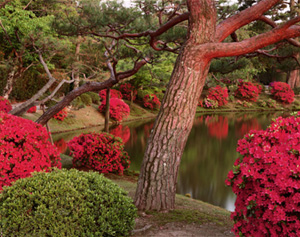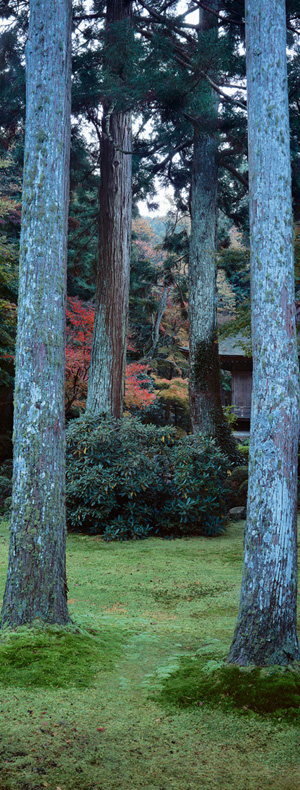By Susan Froyd, 1998
William Corey is a bit baffled. The Boulder photographer, who’s spent the last twenty years making placid images in Japanese gardens, is surprised that so many people—other than a few wealthy collectors—have become interested in what he does.

“It’s hard for people to slow down.” he says. “There is so much pressure to get ahead, be successful, have more and more things.” Corey, though, goes against the grain: He just wants to champion serenity.
That’s why he spends three or four months of every year working in Japan, where in 1996 the government granted him permission to spend the entire summer photographing the Imperial Gardens in Kyoto. That was something no Western photographer had ever done before, and the results are breathtaking: meditative and painstakingly detailed panoramic views of the gardens’ peaceful, shadow-strewn green expanses. Those photos will receive their American debut this week at Camera Obscura Gallery.
Appreciation for Corey’s Kyoto photographs deepens when he describes how they were taken. He uses what’s known as a banquet camera, an instrument developed in the early twentieth century to photograph large groups. He found his in pieces in an antique shop twelve years ago and rebuilt it from scratch with help from an engineer friend.
“It just clicked for me,” Corey says of his secondhand discovery. “I thought, ‘This is the perfect garden camera.'” The contraption, which weighs, with accessories, close to seventy pounds and requires film that has to be custom ordered, allows Corey to work in a large format. The photos show a remarkable amount of detail, aiding in Corey’s quest to capture the elusive Japanese essence. “It’s a wonderful tool and I’m always learning how to compose with it,” he says, explaining that the camera creates extended images that emulate the scroll shape of traditional Japanese art.

In part because of the instrument’s weight and heft, Corey didn’t spend all of his time in the Imperial Gardens with camera in hand. “The photography itself is almost the very end of the process,” he says. “I’d go to the garden for days and days without a camera, trying to get a sense of it. It’s almost like a jigsaw puzzle. As a photographer, I put the pieces together.”
When Corey’s Imperial Gardens works were displayed in Japan, the exhibition was called ‘One Time, One Chance’. It’s not hard to understand why. After spending hours studying the landscape with nothing but his eyes and a sketch pad, when he did turn to the lens, it was a one-shot deal. He only makes one negative of each scene. “Gardens reveal themselves slowly to you,” he says. “I’d try to get my heart and head to match up. Getting that connection is the tough part.”
“Photographers have been taught to stop one moment in time, but I became interested in extending a moment for as long as I could,” Corey says. In an effort to capture the gardens’ timelessness, he began to use longer and longer exposures, varying them from twenty to forty minutes in length. “I’d take a breath, go click, and have to watch the scene every second during that time, because the light was constantly changing,” he says. “Often in the middle of an exposure, a cloud would go in front of the sun and it would become much darker, so it would necessitate increasing the amount of time. Then again, if people walk through the scene while I’m making the picture I won’t stop the exposure because they won’t register on the film. What’s ten seconds in a twenty minute exposure? But if they stop, I close the lens, wait for them to leave and then continue from where I left off.”
In recent times, Corey has switched some of his focus to Italy, a place he says is as different from Japan as a country could be. “In Japan, everything works almost too well,” he explains. “A ten-hour train ride arrives at the exact minute it’s supposed to. In Italy, nothing seems to work, but it doesn’t much matter. It’s kind and relaxed.”
But Japan is still in his blood. “I guess it’s a lifelong project,” says Corey. “I keep on learning and going deeper into it and even though I might never truly understand the meanings behind them my goal has always been to make garden images that are faithful to the ancient traditions while interpreting them in new and different ways.”
Corey, however, seems to have made inroads. “I wanted to photograph what valuable contributions mankind has made to the world,” he says. “Gardens seemed like a good place to begin.”
Photograph and article courtesy Susan Froyd. Originally published by Westword Jun 04, 1998 / New Times, Inc. All rights reserved. © 2002 Colorado ASMP. All rights reserved.